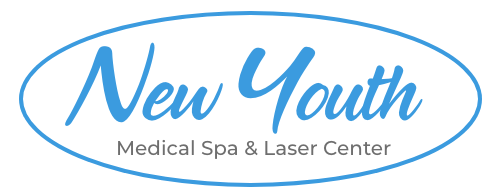Contact Us Today!
912-354-4411
410 Mall Blvd Suite E Savannah, Ga 31406
[hr]
[frame style=”modern” image_path=”https://www.newyouthmedicalspa.com/wp-content/uploads/2014/10/choose-new-youth-savannah.jpg” link_to_page=”” target=”” description=”” float=”” lightbox=”” lightbox_group=”” size=”banner_full”]
[hr]
At New Youth Medical Spa & Laser Center we specialize in providing effective “Anti-Aging Solutions.”
To understand treatment options for the aging face, one must first understand the stages of the aging face.
Dr. E. Ronald Finger, has 35+ years of experience in not only Plastic & Re-Constructive Surgery, but has also developed one of the first truly clinical strength, anti aging skin care systems in the U.S. Rate MD’s Voted Dr. E. Ronald Finger MD, FACS #1 in Georgia and #10 in the U.S.A. for 5-Star Ratings. He has written thousands of articles/blogs over the years. Dr. E. Ronald Finger is a published Author of the book “Why Grow Old.”
His vision for “New Youth Medical Spa & Laser Center”, is to offer a full service medical & anti aging spa. He combines laser treatments, New Youth Skin Care & injectables such as: Juvderm Voluma, Sculptra, Perlane & Botox. In addition New Youth Medical Spa & Laser Center houses Hair Restoration of Savannah, offering NeoGraft Hair Restoration.
Dr. E. Ronald Finger also offers complimentary Plastic Surgery Consults at New Youth Medical Spa & Laser Center.
Patients that decide on surgical procedures will be scheduled in Hilton Head South Carolina, a 45 minute drive from Savannah Georgia. The surgical facility is state of the art and offers newest technology to assure patient comfort and safety.
The ideal treatment of the aging face will incorporate Dermal Fillers, Skin Care & Plastic Surgery (when needed). The team at New Youth Medical Spa & Laser Center looks forward to assisting with all your anti aging needs.
Stages of the Aging Face
[frame style=”shadow” image_path=”https://www.newyouthmedicalspa.com/wp-content/uploads/2014/10/savannah-medical-spa.jpg” float=”right” lightbox=”” lightbox_group=”” size=”portrait_thumb”]Loss of elasticity will occur with time regardless of what we do, but we can drastically increase this loss with excess ultraviolet rays from the sun and smoking. These are the two most influential factors within our control. Of course there is the genetic factor, but we cannot influence this. Most everyone knows about the loss of elasticity, but few people know of the de-volumizing factor, and even plastic surgeons didn’t know the impact of it until the last decade or so.Loss of volume may be more influential in the appearance of our aging process than loss of elasticity. How many times have we seen someone in their 20’s who we haven’t seen in a while and thought or said, “You’ve lost your baby fat?” Well, the problem is that we continue to lose the facial volume (from loss of fat and collagen) as we get older, providing we are not obese. Our skin loses volume and thickness also. The face is the only part of the body where the muscles originate on bone and attach on the skin—for facial expression. This facial expression, however, traumatizes the underlying fat by squeezing it when we smile, frown, squint, etc. Eventually the fat atrophies and withers away, leaving our faces deflated or de-volumized. Our skin loses volume too, accentuated by excess sun exposure. Even our bones atrophy, especially the maxilla and mandible (bones around the mouth), and this is something we can influence. Gum disease and poor dental hygiene are the causes of this bone loss. As the saying goes, “You don’t have to floss all of your teeth, just the ones you want to keep!” Using a sonic tooth brush also helps immensely.
When we lose volume, various areas become hollowed out, such as under the lower eyelids, the tear trough (which creates a depression obliquely across our cheek), the mid-cheek hollow, along the jaw line and basically everywhere. For the visual description of the various areas of lost volume, see the figures below.
Note that in the 20-30 year old the face is fuller and the cheeks are round, extending from the nose to the lower eyelid to a level of the upper lip. At 50-60 years old the tear trough cuts diagonally across the cheek, essentially cutting it in half. The lower lid becomes hollow when the cheek fat diminishes in size. When we lose this fat, we lose support and the skin sags causing jowls, nasolabial folds, and the marionette lines and generalized drooping. Plus, our skin, both dermis and epidermis, is thinner and has a loss of elasticity which allows it to sag more readily.
Face lifts will pull the skin upward and tighten the face, but it is then a tighter, but not re-volumized face. This can look very good, but when the volume is also replaced the face looks much better and younger. Many times patients need more re-volumizing than they do lifting (re-volumizing usually lifts the face anyway). For these patients, my choice of products is Sculptra, which stimulates the tissues to produce collagen, thus volume. This is often in combination with other products, such as Restylane or Juvederm. When necessary, the skin envelope can be further reduced (tightening the skin) with procedures such as the or deep peels, such as the Croton oil peel (or, if necessary, a face lift).
These various combinations are the basis for the non-surgical facial rejuvenation procedures now available. While they may not give the same result as a surgical procedure (especially when combining with re-volumizing), there is minimal down time and the expense is far less. Many face lifts need re-volumizing a year or so following the procedure when all of the postoperative swelling has subsided and from the continuing aging process. Carefully view the drawings below to see the volume loss. Then look at people of different ages, and you will be able to identify and name the various areas of volume loss. If diligent, you can avoid much of it yourself by using sun screens, not smoking, good dental hygiene, and eating for health, particularly reducing or eliminating the simple carbohydrates, rapidly cooked foods and saturated fats.

